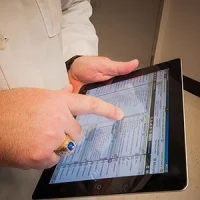Technology is becoming integrated into healthcare processes. In the examination room, for example, use of computers is aimed at promoting safer and more efficient care. However, exam room computing is challenging and there is growing evidence that it can be a threat to patient safety.
There is an urgent need to develop and implement patient-centric, exam room computer-use best practices, according to Regenstrief Institute Investigator and Indiana University School of Medicine Professor of Medicine Richard Frankel, PhD. In previous studies, Dr. Frankel and his colleagues have found wide variation in examination room computer use: some physicians spend more than 80 percent of the visit time interacting directly with the patient, while others spend more than 80 percent of the visit time interacting with the computer screen.
Analysing exam room computer-use, Dr. Frankel has identified gender differences. Female physicians typically look up from the screen approximately every 30 seconds or so, making eye contact with the patient to signal that they are still actively engaged in the relationship, and return to typing. Male physicians tend to lock on to the computer screen and rarely look up to signal engagement.
Studying the patient's perspective, Prof. Frankel has found patients have a preference for doctors who they believed to be paying attention to them. In that study he found that patients who were extremely satisfied with their physician believed that the doctor had spent more time with them than actually was spent.
Based on the results of these studies, Prof. Frankel has devised a model ("POISED") for developing and reinforcing good exam room computer-use by physicians. He presents the model in an article published in JAMA Internal Medicine. POISE includes these key points:
The physicians' need to document must be balanced against the need to build and maintain a relationship with the patient. "Computers in the exam room are here to stay. We need to integrate them into the physician-patient relationship in a patient-centred way. POISED provides a framework for us to do so," says Prof. Frankel.
Source: Indiana University
Image credit: Regenstrief Institute
There is an urgent need to develop and implement patient-centric, exam room computer-use best practices, according to Regenstrief Institute Investigator and Indiana University School of Medicine Professor of Medicine Richard Frankel, PhD. In previous studies, Dr. Frankel and his colleagues have found wide variation in examination room computer use: some physicians spend more than 80 percent of the visit time interacting directly with the patient, while others spend more than 80 percent of the visit time interacting with the computer screen.
Analysing exam room computer-use, Dr. Frankel has identified gender differences. Female physicians typically look up from the screen approximately every 30 seconds or so, making eye contact with the patient to signal that they are still actively engaged in the relationship, and return to typing. Male physicians tend to lock on to the computer screen and rarely look up to signal engagement.
Studying the patient's perspective, Prof. Frankel has found patients have a preference for doctors who they believed to be paying attention to them. In that study he found that patients who were extremely satisfied with their physician believed that the doctor had spent more time with them than actually was spent.
Based on the results of these studies, Prof. Frankel has devised a model ("POISED") for developing and reinforcing good exam room computer-use by physicians. He presents the model in an article published in JAMA Internal Medicine. POISE includes these key points:
- Prepare – review electronic medical record before seeing patient
- Orient – spend 1 to 2 minutes to brief the patient on how computer will be used during the appointment
- Information gathering – don't put off data entry as patients may question how seriously their concerns are being taken if physician does not enter information gleaned from patient into computer from time to time
- Share– turn the computer screen so patients can see what has been typed signalling partnership and also serving as a way to check that what is being entered is what was said or meant
- Educate – show a graphic representation on the computer screen of information over time, such as patient's weight, blood pressure or blood glucose, so it can become basis for conversation reinforcing good health habits or talking about how to improve them
- Debrief – Exam room computers provide an ideal opportunity to use "teach back" or "talk back" format for doctor to assess the degree to which recommendations are understood by the patient and correct as necessary
The physicians' need to document must be balanced against the need to build and maintain a relationship with the patient. "Computers in the exam room are here to stay. We need to integrate them into the physician-patient relationship in a patient-centred way. POISED provides a framework for us to do so," says Prof. Frankel.
Source: Indiana University
Image credit: Regenstrief Institute
References:
Frankel RM (2015) Computers in the Examination Room. JAMA Intern Med. Published Online: November 30, 2015. doi: 10.1001/jamainternmed.2015.6559
Latest Articles
healthmanagement, technology, patient safety, patient-centred, electronic medical records, computers
Use of computers In the examination room is aimed at promoting safer and more efficient care. However, exam room computing is challenging and there is growing evidence that it can be a threat to patient safety. There is an urgent need to develop and imple










